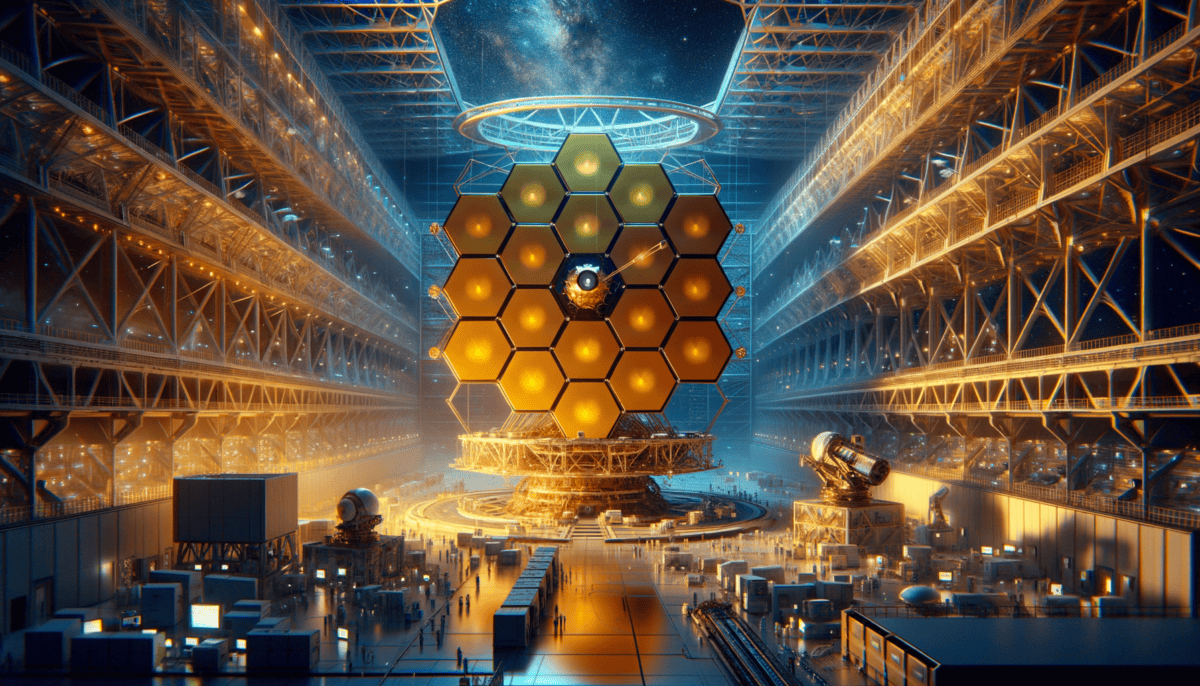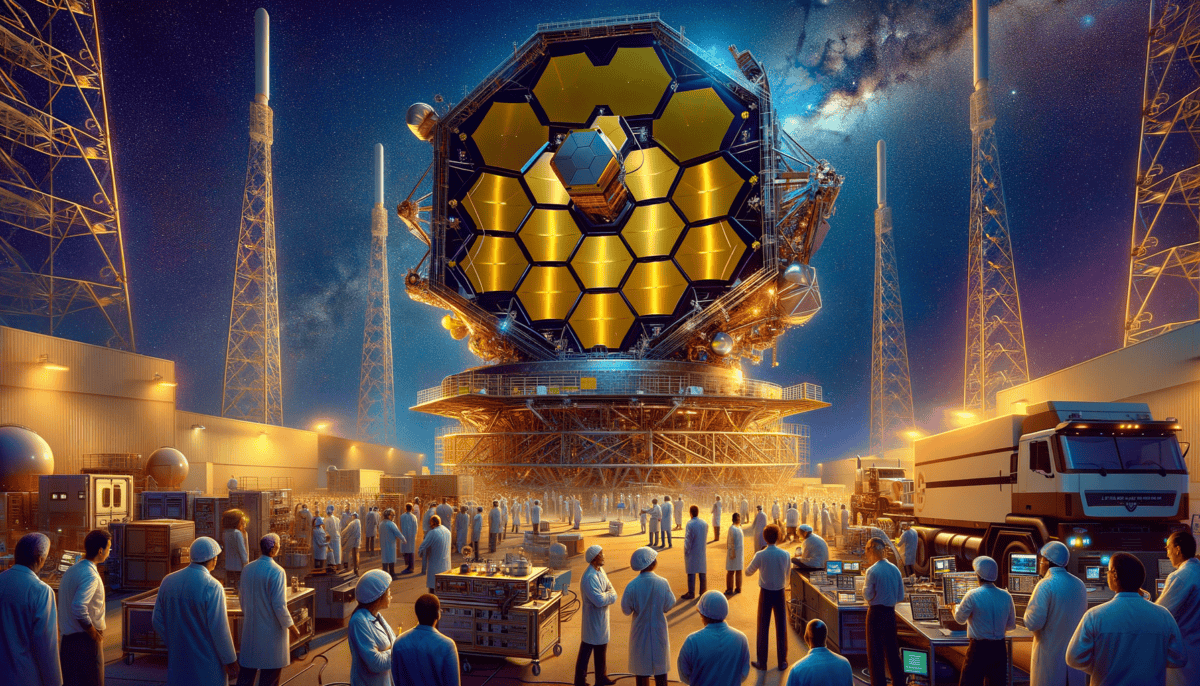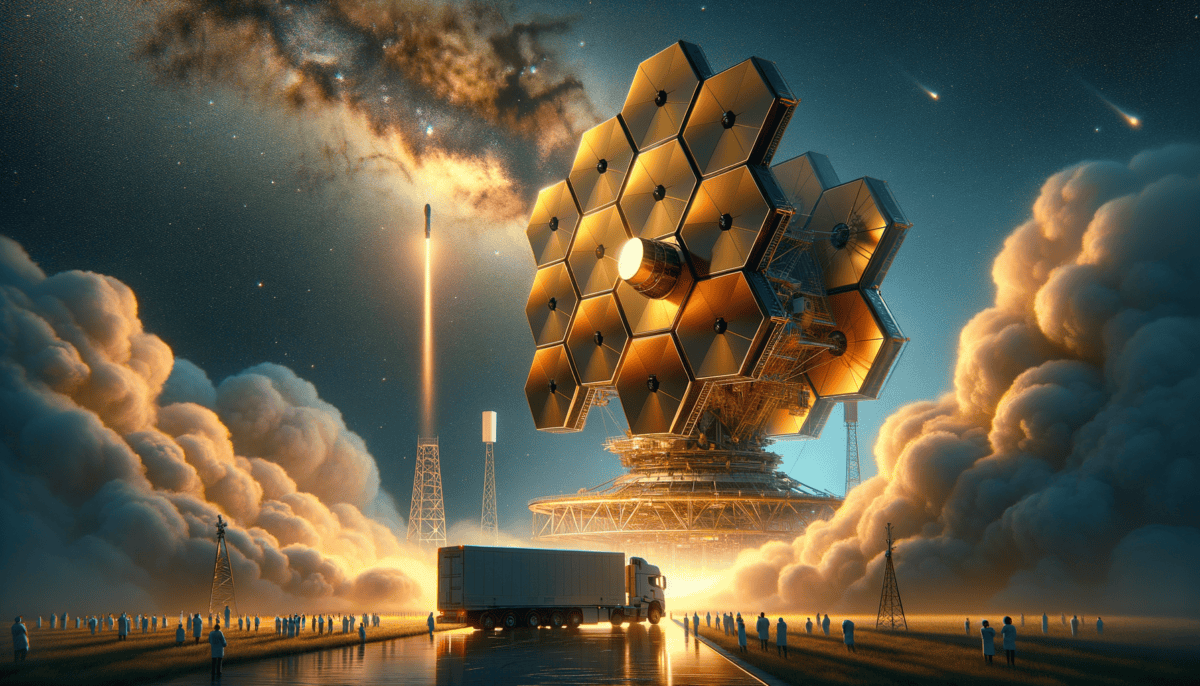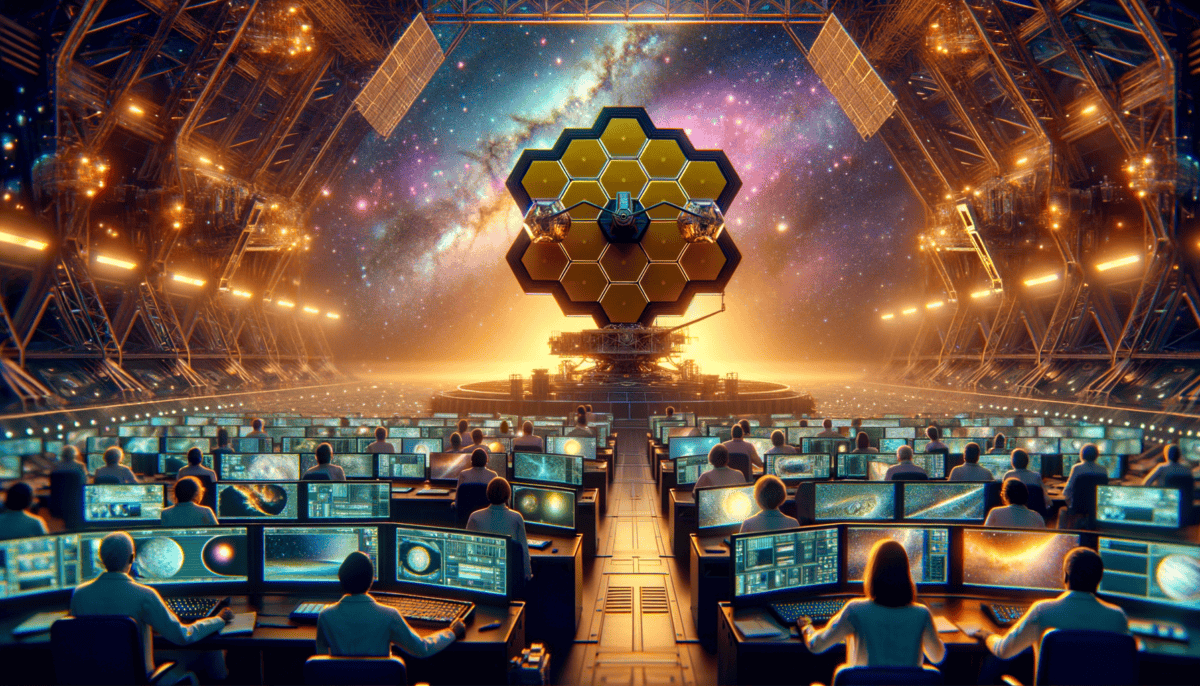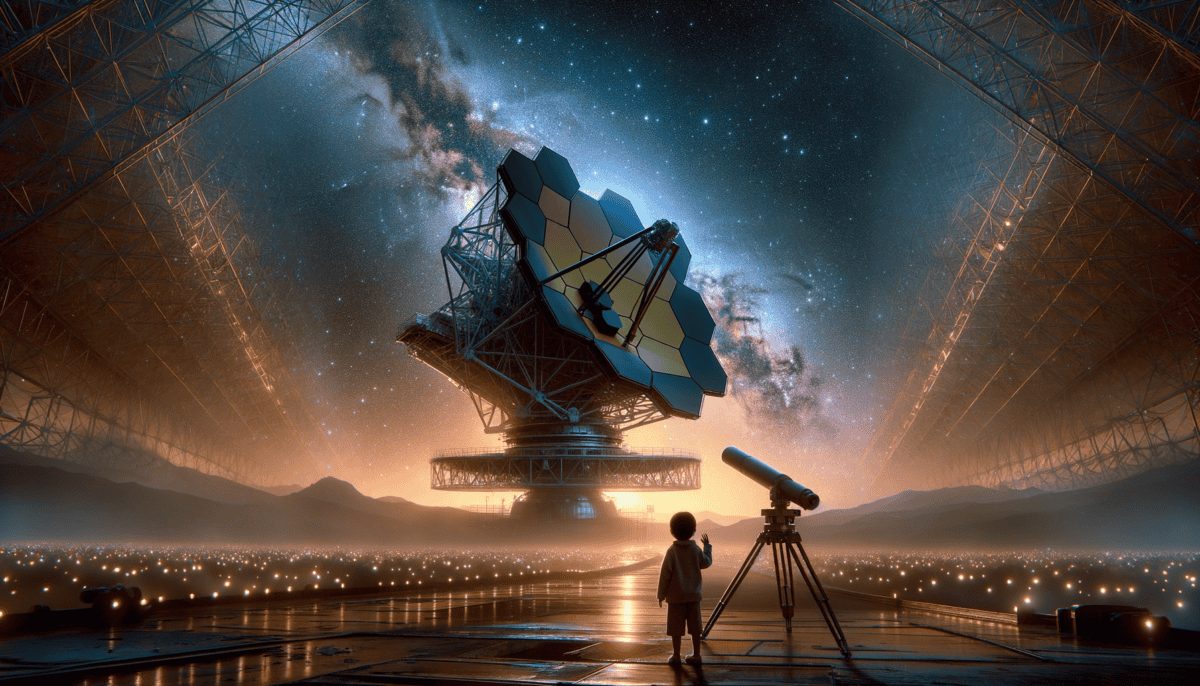A Dream Among the Stars
Sarah loved looking at the stars. Every night, she would peek through her tiny telescope from her backyard. But she wanted to see more – much more! Just like the scientists at NASA who had a big dream.
"Mom, why can't we see further into space?" Sarah asked one evening.
"Well, sweetheart, that's exactly what some very smart people were thinking back in 1989," her mom replied with a smile.
Dr. John Mather had the same question as Sarah. He and his friends at NASA wanted to build something amazing – the biggest space telescope ever! They called it the James Webb Space Telescope. It would be like a giant eye in space, looking at things no one had ever seen before.
"But how big would it be?" Sarah wondered.
"Picture this," her mom explained, "If your telescope is as big as a toy car, the James Webb telescope would be as big as a tennis court! "
The scientists faced many challenges. Building such a big telescope wasn't easy. Some people said it couldn't be done. But Dr. Mather and his team didn't give up.
“We dream big because that’s how we make amazing things happen,” Dr. Mather told his team.
They needed the telescope to be super cold to work properly. It would have to be colder than ice cream in your freezer! ❄️ They also needed special mirrors that could fold up like origami paper and then open up in space.
The Big Plan Takes Shape
Scientists from all over the world joined the project:
• NASA in America
• ESA in Europe
• CSA in Canada
Together, they worked on making their dream come true. They drew pictures, made models, and tested new ideas. Every day brought them closer to building something that would change how we see our universe.
Sarah's eyes sparkled as she imagined it. "So they wanted to see the first stars ever made?"
"Yes! And even more," her mom nodded. "They wanted to look at planets around other stars and see if they might be like Earth."
The telescope would use infrared light – a special kind of light our eyes can't see. It's like having super-power vision in space! ♀️
Sarah hugged her small telescope tight. "I hope I can help build something like that someday!"
Her mom smiled. "That's exactly how it all started – with people looking up at the stars and dreaming big dreams."
As the night grew darker, more stars appeared in the sky. Each one seemed to twinkle with possibility, just like the dreams of those first scientists who dared to imagine the James Webb Space Telescope.
The dream had begun. But building the biggest space telescope ever would take more work than anyone imagined…
Building a Space Marvel
️ “How do you build something that’s never been built before?” Tom asked his dad, a NASA engineer working on the James Webb Space Telescope.
“One piece at a time,” his dad smiled, showing Tom a picture of the giant golden mirror they were making. “And sometimes, we have to invent new ways to do things!”
The mirror was special. It was coated with real gold – but so thin that all the gold used was only as heavy as a candy bar!
“Why gold?” Tom wondered, his eyes wide with curiosity.
“Gold is perfect for reflecting the kind of light we want to see,” his dad explained. “It helps us look at very distant stars and galaxies.”
A Super-Cool Challenge
The telescope needed to be very, very cold to work properly. How cold? Colder than any freezer on Earth! ❄️
“It needs to be negative 388 degrees Fahrenheit. That’s about as cold as a winter day on Pluto!” Tom’s dad explained.
To keep it cold, they built a sunshield. It was as big as a tennis court and thin as a hair! It would fold up like a paper airplane for launch, then open up in space.
Team Work Makes the Dream Work
People from different countries worked together to build different parts:
• USA built the main mirror and cameras
• Europe made special instruments
• Canada created sensors to point the telescope
“It’s like a big space puzzle,” Tom said, watching videos of people in clean white suits working on the telescope parts.
“Exactly!” his dad nodded. “And every piece has to work perfectly.”
Testing, Testing, 1-2-3!
They tested everything many times. The mirror had to unfold just right. The sunshield needed to open perfectly. Nothing could go wrong in space!
“What if something breaks?” Tom worried.
“That’s why we test everything on Earth first,” his dad reassured him. “We shake it to make sure it can handle the rocket launch. We put it in cold rooms to make sure it works in space temperatures.”
The telescope was finally coming together. Each piece was carefully built and tested. It was like building the world’s most complex LEGO set – but in space!
The impossible was becoming possible. But the hardest part was still to come – getting this amazing telescope safely into space…
Ready for Takeoff
The big day was getting closer! After years of building and testing, the James Webb Space Telescope was ready for its journey to space.
“When does it launch, Dad?” Tom asked excitedly, bouncing on his toes.
“On Christmas morning!” his dad replied with a grin. “It’s like a holiday gift to all the scientists who worked so hard!”
Packing for Space
Getting the telescope ready for launch was like packing for the biggest trip ever! First, they had to fold it up very carefully.
“It’s like origami,” Tom’s dad explained. “The telescope is bigger than a tennis court when it’s open, but it needs to fit inside the rocket!”
“The sunshield folds up like a blanket, and the big golden mirror folds like a butterfly’s wings,” he showed Tom on his tablet.
The Big Move
Moving the telescope was super tricky! They put it in a special container and took it on a boat across the ocean.
“Why can’t we just fly it there?” Tom asked.
“It’s too big for a plane!” his dad laughed. “Plus, we need to be extra careful. This telescope cost ten billion dollars to build!”
Getting Ready to Blast Off
At the launch site, everyone was busy doing final checks:
• Making sure all parts were working perfectly
• Checking the rocket engines
• Loading special fuel
• Watching the weather
• Testing all the computers
Tom’s dad barely slept. “We only get one chance to do this right,” he said, looking tired but happy.
Countdown Begins
The night before launch, scientists from all over the world gathered to watch. Some had worked on the telescope for over 20 years!
“Are you nervous, Dad?” Tom whispered.
“A little,” his dad admitted. “But mostly excited. Tomorrow, we make history!”
That night, Tom could hardly sleep. He kept thinking about the giant golden telescope, all folded up like a butterfly in its cocoon, waiting to spread its wings in space.
As the stars twinkled outside his window, he wondered what amazing things they would discover once the telescope reached its home in space…
The Most Important Day
The sun wasn’t even up yet when Tom jumped out of bed. Today was launch day – December 25, 2021!
“Dad! Dad! Is it time?” Tom shook his father awake.
“Yes, buddy! The launch is in three hours!” His dad was already reaching for his phone to check the weather.
Getting Ready for Launch
At the launch site, hundreds of people were busy. The giant Ariane 5 rocket stood tall and proud, with the James Webb telescope safely tucked inside.
“Look how big it is!” Tom gasped, watching on the live video feed.
“That rocket is as tall as a 17-story building!” his dad explained. “It needs to be super strong to carry our telescope to space.”
Countdown Time
Everyone held their breath as the countdown started. Scientists who worked on Webb for years looked nervous and excited.
“Ten… nine… eight…” Tom counted along with the launch control voice.
Blast Off!
When the countdown hit zero, bright orange flames burst from the bottom of the rocket. The ground shook!
“It’s flying!” Tom jumped up and down. “Look how fast it’s going!”
The rocket zoomed up through the clouds, leaving a trail of white smoke behind.
Nervous Minutes
The scariest moments came after launch. The telescope had to:
• Separate from the rocket safely
• Start sending signals back to Earth
• Begin its long journey to its new home
• Stay in perfect condition during the ride
• Start unfolding its parts
“Is everything okay?” Tom asked, seeing his dad biting his nails.
A Perfect Start
Cheers erupted in the control room! Scientists hugged each other, and some even cried happy tears.
“We did it!” Tom’s dad shouted, picking him up and spinning him around.
“What happens next?” Tom asked, dizzy but grinning.
“Now comes the really tricky part,” his dad said. “Webb needs to travel for a whole month to reach its special spot in space. Then it has to unfold itself, like a giant space butterfly.”
As they watched the last bits of rocket smoke fade away, Tom wondered about all the amazing things Webb would see out there in the darkness of space…
First Light and Wonder
Six months after launch, Tom sat with his dad at their computer. They were about to see Webb’s first pictures!
“When will they show them, Dad?” Tom bounced in his chair excitedly.
“Any minute now! NASA is sharing them with the whole world today.” His dad adjusted his glasses, just as excited as Tom. ️
The Deep Space Show
The first image appeared on screen. Tom’s jaw dropped.
“Wow! Look at all those sparkly dots!” he gasped.
“Those aren’t just dots, buddy. Each one is a whole galaxy, full of billions of stars!” his dad explained, eyes wide with wonder.
Space Detective Work
Webb wasn’t just taking pretty pictures. It was solving space mysteries!
“What’s that orange blob?” Tom pointed at the screen.
“That’s a baby star being born!” his dad said. “Webb can see through space dust that used to block our view.”
New Space Colors
Webb sees space differently than our eyes. It uses special infrared light to:
• See through space dust clouds
• Find hidden stars and planets
• Watch galaxies being born
• Study what far-away planets are made of
Surprises in Space
Scientists found things they didn’t expect.
“Dad! They found water on that planet!” Tom pointed to another news story.
“That’s right! Webb can tell what’s in the air around other planets. It’s like a super space nose!”
Happy Scientists
“Remember how nervous everyone was at launch?” Tom’s dad asked. “Now look how happy they are!”
The screen showed scientists celebrating their discoveries. Some were dancing!
“Can Webb take pictures of everything in space?” Tom asked.
“It’s going to try! There’s so much to see out there. Every picture teaches us something new about our universe.”
As they looked at more amazing space pictures, Tom imagined all the wonderful things Webb might find next. What other secrets was space keeping?
“Dad,” Tom whispered, “I think I want to be a space scientist when I grow up.”
His dad smiled. “With Webb showing us so many new things, who knows what you might discover!”
The Future of Space Dreams
One year after Webb’s first pictures, Tom sat in his school auditorium. He was ready to give a special speech about space!
“I’m nervous, Dad,” Tom whispered backstage.
“You’ll do great, buddy. Just share your excitement about Webb like you do at home.” His dad gave him a thumbs up.
A Young Scientist Speaks
Tom walked to the microphone. His space-themed t-shirt sparkled with stars.
“Webb has shown us amazing things this year,” Tom began. “It found new planets, baby stars, and galaxies so far away it makes my head spin!”
Space Mysteries Solved
Tom clicked through his slideshow of Webb’s best pictures. The audience gasped at each new image.
“Webb helped us learn about:
• How stars are born
• What other planets are like
• How galaxies grow
• Where we might find life in space
Making New Dreams
“Because of Webb,” Tom continued, “kids like me can dream bigger about space!”
The Next Adventure
After the speech, Tom’s teacher had news.
“NASA wants schools to suggest new things for Webb to look at,” she said. “Should our class enter?”
“YES!” everyone shouted.
Looking Forward
That night, Tom and his dad stargazed in their backyard.
“What do you think Webb will find next?” Tom asked.
“Maybe signs of life on other planets. Or new kinds of stars. The universe is full of surprises!”
A Space Future
Tom looked up at the twinkling stars. “Dad, I’m going to help build the next space telescope.”
“I believe you will,” his dad smiled. “Webb showed us that when we dream big and work together, nothing is impossible.”
As they watched shooting stars streak across the sky, Tom knew that Webb was up there too, watching the universe and sharing its secrets with everyone on Earth.
Thanks to Webb, we now see our universe in amazing new ways. But the best discoveries might still be ahead. What will Webb show us next? Only time will tell!


